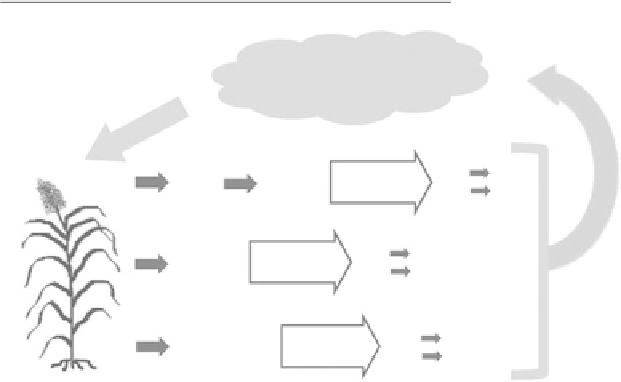Environmental Engineering Reference
In-Depth Information
taBle 11.6
GhG emissions for 100-year Global Warming Potential in co
2
-eq
GhG emissions (mg co
2
-eq/ha)
cs
cc
cc50
cwc70
Agricultural process
23
28.1
55.4
12
Wet milling
79.5
160
158
167
Avoided co-product systems
1.3
-137
-136
-143
Soybean milling
13.7
-
-
-
Biodiesel production
6.2
-
-
-
B20 driving
127
-
-
-
Avoided B20 driving system
-157
-
-
-
Corn stover conversion
-
-
4.2
6.2
Avoided electricity
-
-
-38.1
-56.1
E10 driving
1794
3618
5067
5967
Avoided E10 driving system
-1923
-3877
-5431
-6395
Total
-35.4
-209
-320
-442
Source:
Kim, S. and Dale, B.E.,
Biomass Bioenergy,
29, 426-439, 2005.
Atmospheric CO
2
CO
2
VO
CO
Vehicle
combustion
CO
2
CO
2
Juice
Ethanol
CH
4
CO
2
VO
CO
Process
combustion
CO
2
CO
2
Bagasse
CH
4
CO
2
Field
burning
VO
CO
CO
2
CO
2
Straw and
leaves
CH
4
Sugarcane
FIGure 11.14
Brazilian sugarcane carbon cycle, as modeled by GREET. (From Wang, M., et al.,
Well-to-
Wheels Energy Use and Greenhouse Gas Emissions of Brazilian Sugarcane Ethanol Production Simulated
by Using the GREET Model
, Argonne National Laboratory, Argonne, IL, 2007.)
nitrogen applied to the field, by weight, would be released as N
2
O. The organic carbon content of
the soil was assumed to remain constant. However, the resulting net carbon release could increase
if sugarcane ethanol production causes direct or indirect land-use change—an issue discussed in
greater detail in Section 11.4. The sugarcane carbon cycle, as modeled by Wang et al. (2007), is
shown in Figure 11.14. Note that VOCs and CO were assumed to oxidize and become CO
2
within
days of release to the atmosphere. Only CH
4
emissions (see Figure 11.14) were included in the cal-
culation of GHG emissions from field burning.
According to the analysis, nearly 70% of life-cycle greenhouse gas emissions were due to grow-
ing and harvesting sugarcane. Figure 11.15 shows the base case well-to-wheel GHG emissions of
Brazilian sugarcane ethanol. Burning of sugarcane fields contributed 24% of total life-cycle GHG
emissions, in the form of CH
4
. It should be noted, again, that this practice is being phased out, and
emissions from this source are assumed to be zero by 2020 in the GREET model.




